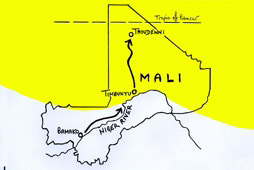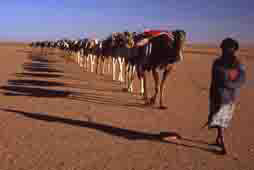
 Salt caravan
Salt caravan
 Salt caravan
Salt caravanStrolling by the River Niger in Bamako, I had to pinch myself and remember that this was the capital of the largest country in West Africa. Under the flowering Jacarandas sheep lay about; at the water’s edge women scrubbed clothes and men scrubbed motorbikes; cicadas buzzed; and as dusk fell frogs began to croak. I turned into a wide avenue. It was nearly rush hour but there wasn’t a traffic jam to be seen.
My first few days in Mali turned my preconceptions on their head. I expected heat, dust and hassle and found heat, dust and unbelievable friendliness. “Bonjour monsieur, ça va?” is ringing in my ears. Initially my needs were a bit unusual – Camping Gaz cylinders, a pair of Walkman headphones, and a tailor who could do press-studs – but strangers guided me happily round Bamako’s markets till all three were found.
Not so easy to find may be transport downriver. From November the Niger’s water level drops dramatically; looking down from one of Bamako’s bridges, I could see the bottom. Just below the city are rapids which put a stop to all river transport, so on 5th December I took the evening bus to the port of Koulikoro, 40 miles downstream. The journey took longer than I expected; the sun sizzled into the red earth and paraffin lamps started to flicker at the roadside stalls. As the evening wore on, passengers got off at intervals and drifted away into the night.
Koulikoro turned out to be just a string of huts and compounds, with the Niger glinting in the moonlight beyond. At the far end of the village the bus reached its terminus, and a boy was commandeered to guide me onwards. He insisted on carrying my rucksack, and ten minutes later deposited me and rucksack at Koulikoro’s guesthouse and melted away. I settled down to supper in a cool palm-fringed compound, thinking how typical this was of the Malians I’ve met so far. Nothing has been too much trouble, and after a week in the country I can say that even the tiniest children have been impeccably behaved. This isn’t to say I haven’t seen some shocking things. Mali is the world’s fourth poorest country (after Sierra Leone, Niger and Burkina Faso) and it shows. Outside the capital many shops offer little more than rice, millet and cigarettes, which can be supplemented by bananas and yams from roadside stalls. Markets are even more impoverished, except once a week when the animal markets take place and every town and village becomes a seething mass of sheep, goats, donkeys and cattle.
This scarcity of even the most basic necessities reminds me of Cambodia when I was there in 2003. In that case the capital was more sophisticated, but the countryside and villages even more basic. In Mali at least the ox-carts have tyres.
Having observed this, I’m already beginning to look in wonder at Malians as they go about their daily chores. Tall and statuesque, they walk with a spring in their step and always with head held high. In the case of women this is often because they’re carrying a tray of fruit on their head, a balancing act which they perform with disarming casualness; but it seems to me that people stride along with pride and dignity whatever their situation.
One thing that’s truly miraculous is that AIDS hasn’t yet decimated Mali’s people. Only two percent of adults are HIV positive, compared with twenty percent in South Africa for instance. Not that the Government doesn’t take it seriously. “Ensemble, nous stoppons le SIDA,” read a poster I passed yesterday. The ‘stoppons’ made me chuckle. Malians speak with a thick accent but I hadn’t come across them making up words before.
At Koulikoro the Niger was wider than at Bamako, but still there was no river traffic. I’d read that the Bozo people of the area are renowned fishermen, and sure enough a few distant figures were out in tiny pirogues – no more than dugout canoes really – drawing in nets. As they punted back and forth their punt-poles struck bottom at only two metres, even in midstream.
So I wasn’t completely surprised when I strolled into the port area to find two of the big Niger ferries parked up for the season. The Kankou Moussa and Tombouctou spend July to November ferrying people by the thousand between Koulikoro and Gao, a round trip of more than 1,500 miles. I climbed the rattling gangplank, and nosed round echoing decks that showed all the scars of their long, hardworking lives. Every railing bulged outward, every steel plate caved inward, every corner of these beautiful floating rustbuckets had been rubbed smooth by the pressure of bodies and baggage.
A man sauntered up and introduced himself as Yusuf Megar, captain of the Kankou Moussa. He gave me a full conducted tour, including the bridge, and rounded it off by asking if I could give him 50p for lunch. “They don’t pay me when the boat isn’t running,” he explained.
In the town of Ségou, 100 miles downstream, the news on the river was the same. “You should have come a month ago,” they said ruefully. Here at least pirogues were ferrying people in a businesslike fashion
from bank to bank, so I hopped on one and explored the other side.
It was a revelation. There were no vehicles and no electricity,
and these two things changed everything. Ségou, 20 minutes
across the river, might have been on another planet. Here people
lived in thatched mud houses and children played naked in the
dust. I ate a free-range omelette at a riverside stall, then walked
out into the millet fields. The village chatter faded behind me.
I was in Africa at last.
